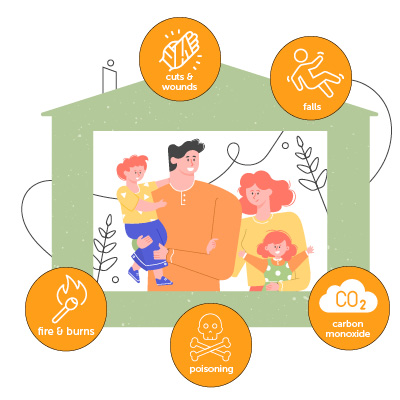Vitality eNews Sign Up
Receive the Summa Health eNewsletter for the latest health tips, advice and updates.
5 tips for safeguarding your home against preventable accidents
Posted December 27, 2021 by Shivonne N Suttles

When you think of home, you often think of it as your safe haven from the outside world. It’s your safe space you get to return to every night.
The sobering reality, however, is more than 50 percent of unintentional injuries happen in or around the home, according to the National Security Council (NSC). People of certain ages, especially young children and the elderly, are more susceptible to serious injury from household hazards.
The good news is many of them are preventable. Summa Health offers a guide to minimize your home’s top 5 hidden dangers and ensure your safe haven is even safer for you and your loved ones.
- Preventing accidental poisoning
Accidental exposure to medications and chemicals account for more than 90 percent of calls reported to poison control centers. In fact, it’s the leading cause of injury and deaths in homes, according to the NSC.
For this reason, it’s a good idea to keep the phone number of your local poison control center handy. To reduce the risk of accidental poisoning to at-risk age groups, be sure to keep these items locked up or out of reach:
- All medications (both prescription and over the counter) and vitamins
- Household cleaning products, pesticides, cosmetics, paints, hand sanitizer, and dish and laundry detergent pods
- Alcohol
- Tobacco and E-cigarettes, especially liquid nicotine
- Button batteries, found in toys, key fobs, hearing aids, watches and more. They also can pose a choking hazard to small children.
- Preventing falls
From falling off stepladders to slipping in the bathroom, falls are the second-leading cause of injury and death in the home, according to the NSC. Take these simple steps to reduce your risk of falls:
- Place nonslip mats under area rugs or remove them altogether.
- Install railings and good lighting on all staircases.
- Mount gates at the top and bottom of stairways if you have small children.
- For older adults or those with balance issues, add grab bars or place a chair in the shower. A rubber mat on the shower floor can help prevent slips, too.
- Clean up spills or wet floors immediately.
- Clear outdoor stairs and walkways of wet leaves, snow and ice.
- Preventing fire and burn hazards
From minor smoke damage to complete devastation, fires can get out of hand quickly and lead to burn injuries or even loss of life, in worst-case scenarios. Safeguard your home and family by following these tips:
- Keep your chimney and dryer vent clean, well ventilated and free of debris.
- When cooking, place pots and pans on back burners to avoid scalds and burns in case of spills.
- Replace open flame candles with flameless options.
- Ensure you have working smoke detectors on every floor of your home. Change the batteries every 6 months and replace entire units after 10 years.
- Keep matches and lighters out of reach of children.
- Never smoke in bed. Bedding and mattresses are highly flammable.
- Keep a working fire extinguisher in your home.
- Unplug small appliances when not in use.
- Don’t use space heaters that are not UL-approved, which indicates the product meets Occupational Safety and Health Administration requirements.
- Preventing carbon monoxide poisoning
Carbon monoxide is known as a silent killer because the poisonous gas is odorless and colorless. A few ways to prevent exposure to carbon monoxide include:
- Maintain your furnace. A cracked heat exchanger or broken vent can allow carbon monoxide to leak into your home. Have your furnace serviced in the fall to ensure it’s running properly.
- Use a carbon monoxide detector in your home. If it goes off, immediately open windows, leave the house and call the fire department.
- Make sure fireplaces are clean and the flue is open when burning a fire.
- Never leave vehicles running in an attached garage.
- Preventing cuts and wounds
- Storing sharp knives in a knife block.
- Always holding knives by their handles.
- Securing utensils, such as peelers, graters and scissors, as well as breakables (like glassware), out of reach of small children.
- Being careful when handling opened cans. Their edges can cause nasty gashes.
Sharp objects can accidentally cause a cut or laceration, but proper handling and storage of these items can minimize the danger and lessen the chances of a trip to the emergency room for stitches. Reduce your risk by:
When creating a safer home for you and your loved ones, consider the ages of the people you live with and take the necessary precautions to protect them from harm. You will feel more confident knowing your home and loved ones are safer because of it.
